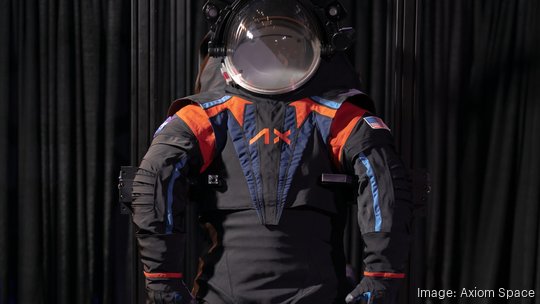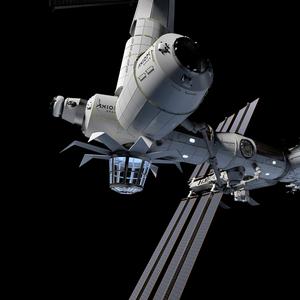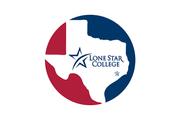
Houston companies will help NASA Mission Control on Earth see the moon’s surface through the eyes of astronauts.
Houston-based Axiom Space and Nokia Corp. (NYSE: NOK) will partner to integrate 4G/LTE into spacesuits that Axiom Space is designing for its upcoming missions, including NASA’s Artemis III mission. Thierry Klein, president of Bell Labs Solutions Research at Nokia, told the Houston Business Journal via email that the partnership was the first between the two companies.
"All future crewed and uncrewed missions will depend on reliable and powerful wireless connections to accomplish their goals: astronaut-to-astronaut and astronaut-to-mission-control communications, remote command-and-control of robots and vehicles, telemetry data, video and transmission of data from scientific experiments and explorations," Klein said. "Cellular networks will be able to support habitat infrastructure and mission goals by linking sensors and connecting transport vehicles, scientific payloads, exploratory drones and rovers. Cellular links could be used to remotely operate dangerous machinery necessary for survival, such as mining and construction equipment."
Separately, Nokia will also fly a payload onboard Houston-based Intuitive Machines Inc.'s (Nasdaq: LUNR) second mission to the moon, IM-2. That payload will establish the first step of what is known as the Lunar Surface Communications System (LSCS). IM-2 is targeting a launch date of late 2024 or early 2025, Intuitive Machines CEO Steve Altemus said during an earnings call last week.
The LSCS has two components: a network-in-a-box, which combines the radio, base station and core network elements of a terrestrial cellular network into a single unit, and device modules that will be integrated into the AxEMU spacesuits. 4G/LTE was selected as a standard that could be used across multiple different systems.
Klein said the system is capable of "self-deploying, self-configuring and self-healing" and that the network could function even with low power supplies.
"While [the LSCS] is a 4G/LTE system at its heart, it is unlike any cellular network on Earth," Klein said. "Nokia Bell Labs completely reconceptualized the hardware and software design of a terrestrial 4G/LTE network to prepare the system for the unique operating parameters of a lunar mission and the harsh conditions of the moon’s surface. Both the network and the device modules have been carefully engineered to withstand the extreme environmental conditions on the lunar surface, including radiation, extreme temperature variations and the moon’s complete lack of atmosphere. Further, the equipment is designed to withstand the dynamic stresses of launch, spaceflight and lunar landing, as well as to meet Artemis III’s rigorous weight, size and power limitations."
Klein added that while 4G/LTE is still the most common network on Earth today, future updates could test 5G or even 6G capabilities. Networks beyond 5G are still being rolled out across Earth, including in Houston.
The spacesuits are being assembled at Axiom’s suits lab, which is in the former NASA Gemini building at 600 Gemini St. in Webster, and Nokia confirmed that integration of the 4G technology is also taking place in Houston. In 2022, Axiom Space won a $228.5 million contract order to develop moonwalking spacesuits for the Artemis III mission, resulting in prototypes that were showcased the following year. The company then received a $57.5 million task order from NASA to integrate the Nokia technology.
“Axiom Space is excited to work with Nokia to build on the advanced capabilities of our next-generation spacesuit,” Russell Ralston, Axiom Space executive vice president of extravehicular activity, said in an Aug. 21 news release. “Adding high-speed 4G/LTE network capability on the moon will serve as a vital bridge linking astronauts to Earth, facilitating crucial data exchange, and enabling high-definition video communication over long distances.”
According to Nokia’s 2024 annual report, the company was first selected to deploy the LTE solution on the moon’s surface in 2020. While the 4G integration task is the company's first operation involving spacesuits, Bell Labs research was involved in several historic space programs, including the launch of Telstar 1 in 1962.
Intuitive Machines and Axiom Space share a co-founder, Kamal Ghaffarian, who is currently the interim CEO of Axiom Space after Michael Suffredini stepped down in August. According to Intuitive Machines' most recent quarterly report, the companies have done business with each other previously, with $50,000 in accounts receivable related to Axiom Space.
Sign up here for the Houston Business Journal’s free morning and afternoon daily newsletters to receive the latest business news impacting greater Houston.





